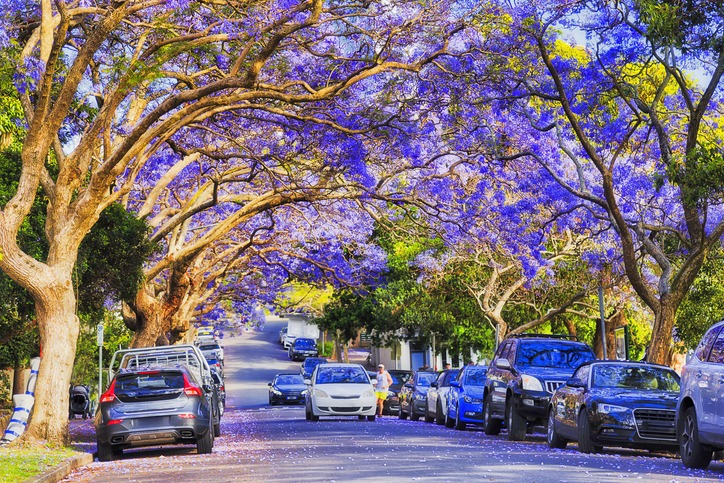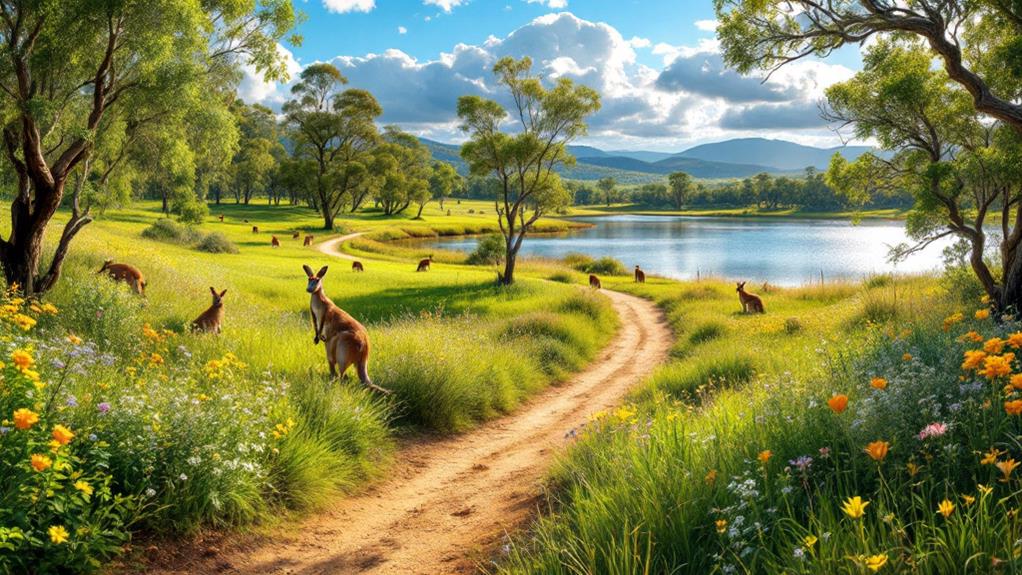When Is Spring in Australia? A Seasonal Guide

Spring in Australia runs from September 1 to November 30, offering a delightful season of mild temperatures and colorful landscapes. You'll find average temperatures from 18.5°C to 24.5°C (65.3°F to 76.1°F), with cities like Sydney experiencing increased rainfall and more sunny days. This is the perfect time to enjoy blooming jacarandas, golden wattle, and lively wildflowers. It's also peak season for spotting wildlife, like koalas and kangaroo joeys, as warmer weather brings a flourish of activity. Uncovering spring in Australia means you're in for stunning natural beauty and exciting outdoor adventures. There's much more to reveal about this dynamic season.
Understanding Australia's Seasons
Australia's unique geographical location in the Southern Hemisphere means its seasons are opposite to those in the Northern Hemisphere. So, when you're basking in the warmth of a Northern Hemisphere summer, Australians are experiencing winter. As you investigate the seasons in Australia, you'll find that the timing and characteristics of each one vary greatly across regions, especially in the Northern Territory.
In Australia, spring kicks off on September 1 and wraps up on November 30, marking a time of year when the country bursts into life. During this season, the landscape transforms with blooming jacarandas and wildflowers, creating lively scenes that are a feast for the eyes. It's not just the flora that comes alive; wildlife is more active, with young koalas and kangaroo joeys emerging from their mothers' pouches.
In the Northern Territory, this time of year also signals the change from the dry season in the tropical north. You'll notice cooler temperatures, especially in the outback, providing a revitalizing break from the intense heat. Understanding these seasonal shifts helps you appreciate the diverse climate and natural beauty Australia offers throughout the year.
Defining Spring in Australia

Spring in Australia is a lively and rejuvenating time, officially starting on September 1 and ending on November 30. Unlike the Northern Hemisphere, where spring signifies a thaw from winter, Australia's spring brings mild to warm temperatures, averaging between 20-25°C (68-77°F). This is the perfect time to enjoy outdoor activities and witness nature at its best. Here's what makes spring in Australia unique:
- Floral Spectacle: Jacarandas and wildflowers bloom, transforming urban and rural landscapes into colorful displays of beauty. You'll find these stunning scenes perfect for photography or a leisurely stroll.
- Wildlife Awakening: Spring sees koala and kangaroo joeys emerge from their mothers' pouches. It's a great opportunity to observe these adorable creatures in their natural habitats.
- Seasonal Shift: In the Northern Territory, spring marks the final months of the dry season. Temperatures become milder as the region prepares for the wet season.
- Outdoor Activities: With pleasant temperatures, spring is ideal for hiking, picnicking, or simply enjoying the great outdoors. It's a season that invites you to investigate and reconnect with nature.
Embrace this delightful time and experience all that spring in Australia has to offer.
Springtime Weather Patterns

As you welcome springtime in Australia, the weather patterns shift distinctly, offering a mix of mild temperatures and increased rainfall. Spring officially starts on September 1 and runs until November 30, bringing pleasant changes to the climate. In Sydney, you'll experience average maximum temperatures ranging from 20.6°C to 24.8°C (68.9°F to 76.6°F), while minimum temperatures hover between 10.4°C and 15.4°C (50.7°F to 59.7°F). This season is perfect for enjoying outdoor activities as the temperatures remain comfortable.
Rainfall also becomes more frequent in spring, particularly in places like Sydney, where you can expect around 8 rainy days each month. This increase in rainfall helps nourish the environment, preparing it for the lively display of nature that follows. However, don't be surprised if you encounter some dry conditions, especially in the tropical north, where the residual effects of the dry season can still linger.
In contrast, southern regions begin shifting to warmer weather, making it an excellent time to uncover the outdoors. Spring in Australia is a time of renewal and transformation, with its unique weather patterns offering an invigorating and revitalizing experience.
Flora and Fauna in Spring
The vibrancy of Australia's spring is a celebration of life, as the landscape bursts into color with blooming wildflowers like the golden wattle, the nation's floral emblem. This season, running from September to November, brings a unique blend of flora and fauna that captivates nature enthusiasts. You can witness koala and kangaroo joeys making their initial appearances outside their mothers' pouches. It's an incredible experience to see these young animals exploring their surroundings.
Birdlife flourishes during spring, with magpies and honeyeaters becoming more active and vocal. Their songs fill the air as they engage in courtship and nesting behaviors. Meanwhile, migratory species, including the eastern curlew and monarch butterflies, make their seasonal return, adding to the diversity and vibrancy of the landscape.
Here are some highlights of Australia's spring flora and fauna:
- Golden Wattle: Australia's national floral emblem brightens the landscape with its golden blooms.
- Koala and Kangaroo Joeys: Watch these adorable creatures venture out, enjoying the milder weather.
- Bird Activity: Listen for the calls of magpies and honeyeaters as they nest and court.
- Migratory Species: Look for the eastern curlew and monarch butterflies returning to Australia.
Spring isn't just about the plants and animals; it's also an essential time for farmers, as the milder weather and increased rainfall support crop growth.
Regional Spring Highlights

Often considered a season of transformation, Australia's spring showcases regional highlights that captivate both locals and visitors alike. Spanning the months from September to November, this season marks a shift from chilly winter days to welcoming warmth. In urban areas like Sydney, jacarandas burst into bloom, painting the cityscape in lively purples. A stroll through these blooming streets is nothing short of mesmerizing.
Head out to the countryside, and you'll be greeted by fields of wildflowers that blanket the landscape. It's an ideal time to witness nature's artistry, with colors and scents that define the season. Spring also brings increased wildlife activity. You'll find koala and kangaroo joeys emerging from pouches, embodying the spirit of renewal and new beginnings.
The outback, with its cooler daytime temperatures and mild nights, invites you to investigate its vast natural beauty. It's perfect for hiking and camping under the stars. Meanwhile, major cities come alive with festivals, celebrating spring's lively atmosphere. Regardless of being a local or a visitor, these events offer a taste of Australia's rich culture and spirited essence, making every moment of spring memorable.
Indigenous Seasonal Perspectives
While spring in Australia enchants with its lively cityscapes and wild landscapes, Indigenous Australian communities offer a unique perspective on this season. It's significant to keep in mind that many Indigenous groups recognize up to six distinct seasons, reflecting a deep connection to the land. These indigenous seasonal perspectives often rely on ecological indicators, like the blooming of certain plants or animal migration patterns, rather than the traditional four-season model. Understanding these perspectives can enrich your appreciation of Australia's natural diversity.
Consider these fascinating examples:
- Yolŋu Seasons: In Arnhem Land, the Yolŋu people identify seasons such as "Djambatj" (the season of heavy rains) and "Gurruŋu" (the season of the cold winds), based on local environmental changes.
- Noongar Calendar: The Noongar people of southwestern Australia have a six-season calendar, including Birak (early summer) and Bunuru (late summer), each with its own cultural significance and activities.
- Ecological Indicators: These calendars incorporate natural markers, from plant blooms to animal behaviors, offering a sustainable way to engage with the environment.
- Ecological Knowledge: Embracing indigenous seasonal perspectives highlights the significance of ecological knowledge and sustainable practices in managing Australia's diverse ecosystems.
Tips for Spring Travelers

Welcome the wonders of spring in Australia by planning a trip that takes full advantage of the mild weather and beautiful landscapes. Start your expedition in Western Australia, where lively wildflower displays transform the landscape into a colorful paradise. With spring temperatures ranging from 18.5°C to 24.5°C (65.3°F to 76.1°F), it's perfect for outdoor activities like hiking and exploring nature reserves.
Travelers should pack wisely for varying temperatures. Lightweight clothing is ideal for daytime adventures, while a light jacket will keep you comfortable during cooler evenings. Don't forget sunscreen, as UV exposure increases during spring, even on cloudy days.
Spring is also a great time to engage yourself in Australia's spirited culture. Attend major festivals in cities like the Melbourne Festival, or indulge in local cuisine at food and wine events. Wildlife parks are a must-see, especially to witness adorable koala and kangaroo joeys emerging from their mothers' pouches.




